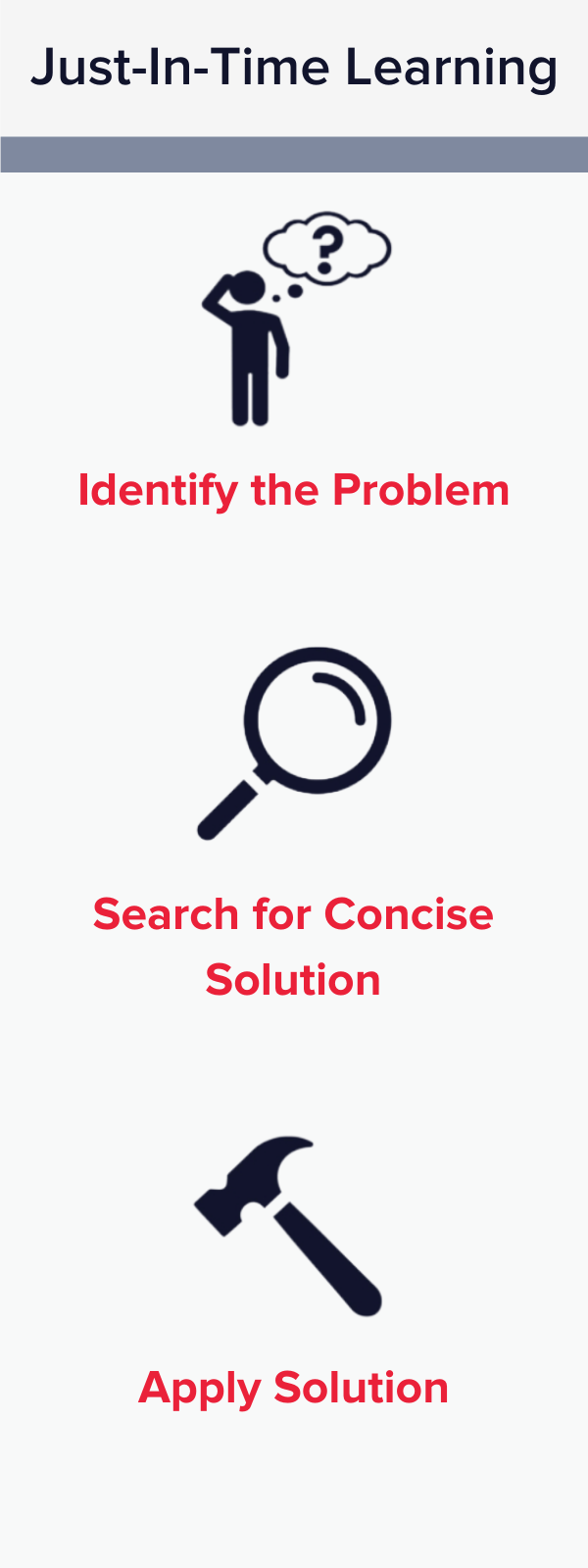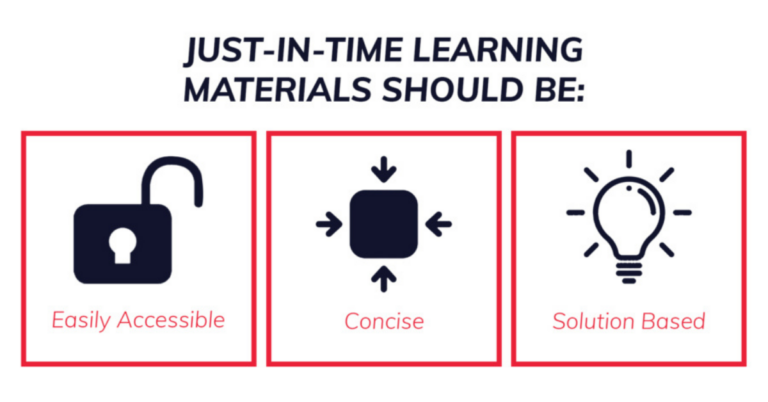Called by many names—point-of-action, point-of-need, prompter support, or just-in-time training (JITT)–just-in-time learning connects users to information at the moment of need. JITT learning is at play whenever you watch a how-to video to learn how to stop your toilet from running or read an IKEA manual to assemble your new couch.
With just-in-time learning users access and apply learning to solve problems in real time. Field technicians who arrive on site might first pull out a tablet and review the model-specific features of the equipment before they even leave the truck to begin the service call. Similarly, nursing staff might access the hospital LMS resources to confirm patient discharge procedures following an out-patient surgical procedure.
The learning materials might help an employee refresh an existing but unused skill, or they might extend learning by pairing a visual demonstration with an explanation and then encouraging the user to emulate the task. Either way, the goal of just-in-time learning is a performance-based outcome—i.e. completing a task, not fact finding with Google. This approach is not meant primarily to improve knowledge recall or support long-term learning. Rather, just-in-time learning helps individuals solve immediate or near-term problems. And that might be a one-off task (e.g. installing and setting up a home WIFI network), or it might occur more regularly (e.g. completing a quarterly self-evaluation).
With the abundance of source material available on the Internet, would-be learners have found YouTube to be a convenient, well-stocked destination. But to ensure accuracy and consistency, organizations may choose to make vetted and curated resources accessible in a searchable or indexed database.

Benefits of Just-in-Time Learning:
- Improves Access—delivering a precise dose of needed content wherever and whenever users demand means more efficient, confident, and competent problem solving. Particularly useful for users who operate outside an office: field workers, technicians, sales staff (pre-COVID).
- Enhances Productivity—employees looking for help spend minimal time finding or waiting for answers. Instead, they proactively find solutions. Meanwhile, experienced employees, the natural target for new-hire questions, freed from this responsibility, suffer fewer interruptions to their workflow.
- Ensures Consistency & Accuracy—collective employee resources centralize access to the identical, approved, and up-to-date information that users need. By drawing on common learning materials, tasks become predictably and more accurately completed. And rather than scheduling in-person learning sessions to keep employees current, pushing content through the organization’s LMS saves time and delivers resources only at the moment they become necessary.
- Boosts Confidence—when employees can perform their job functions with greater autonomy and precision, they also grow in confidence. This self-reinforcing pattern leads to better performance and higher levels of job-satisfaction and employee morale.
- Catalyzes Employee Learning—motivation to learn climbs when employees need to find a solution to a problem. Encouraging folks to take an active role in their learning helps them to access related prior knowledge and extend existing skills in new contexts or directions.

Examples of Just-in-Time Learning:
Giving up-the-minute COVID information to health care professionals, Knowledge to Practice has introduced an alternative to traditional continuing medical education practices, previously delivered in multi-day conferences and dense, long-winded literature reviews. Delivering ‘breaking’ medical news and updates the moment it’s required, KtP makes physicians confident of making more accurate diagnoses, giving better treatment recommendations, and improved decisions regarding complications.
The Cleveland Clinic, responding to an internal statistic suggesting that 70% of what their employees need to know is learned on the job, has made just-in-time learning a priority. QR codes placed conveniently on equipment and beside patient beds offer immediate and accessible learning opportunities. When scanned by a mobile device, employees receive essential need-to-know information on demand. Each scan is subsequently logged and connected to an employee’s digital learning profile. This data can help management track employee progress and spot additional training that might be required. Such informal learning is both minimally disruptive to the daily workflow and immediately applicable, creating efficiencies across the entire organization.
Rob Kenney is just one of a growing number to share their knowledge and skills on YouTube. His channel Dad, How do I? has attracted millions of viewers for his straightforward and encouraging household-skill tutorials. Would-be DIYers needing a practical and immediate dose of “dadvice” to solve emergent problems look to Rob for instruction and inspiration. Whether it’s a flat tire that needs changing, a new shower head that needs installing, or a home security system that needs setting up, Rob has a step-by-step answer for you. Beyond the videos, the comments section resolves any FAQs and creates a supportive community. And for those nights when you simply don’t have the energy, Rob will even read your kids a nighttime story. Who needs to call a professional when genuine, patient help is merely a couple clicks away?
Just-in-time learning strategies offer invaluable resources for medical professionals just prior to or at the time of patient contact. A 2015 study brought JITT to nearly 100 neonatal nurses working in the intensive care unit, where fragile lives hang in the balance and quality improvement initiatives are a top priority. The 10-15 minute small group, active engagements improved specific knowledge of the nutrition initiative and directly impacted the bedside care for newborns and their mothers.

